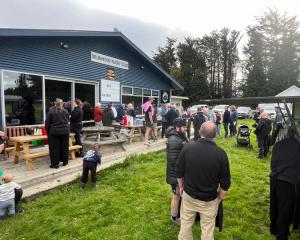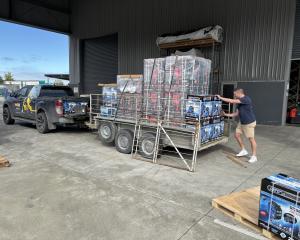Thirty years ago, the Waihopai River broke its banks near Invercargill, causing widespread damage and forcing the evacuation of about 4000 people from 1000 homes. Allison Rudd looks back.
On a sunny Friday morning 30 years ago, sick of being cooped up inside in the family's Douglas St home in Invercargill after several days of intense rain, Bill McKay took his three young sons for a walk to look at the puddles.
What he saw at the street end of his leg-in driveway surprised him - a torrent of water a few centimetres deep flowing along Douglas St from North Rd.
Mr McKay and his wife Trish, who still live in the same house today, did not know it then, but the banks of the Waihopai River had burst and their home, along with about 1000 others in the suburbs of Grasmere and Collingwood, would soon be flooded.
Within an hour they were rescued by boat at their front door. It was months before they were able to move back into their home.
Mr McKay said he did not think the water flowing along Douglas St was a problem.
''Our car was parked in the driveway outside the garage, so I put it away. We had had the fire on that morning, and I also remember going out and emptying the ashes into the ash bucket. I just thought there would be flooding on the road, but the water kept coming.''
The McKays, who moved into the house when they married in 1975, had not long finished redecorating and adding on a living room.
They remember the speed with which the water rose that day. It eventually reached a depth of 1.4m.
''You could hear the water coming up under the house,'' Mr McKay recalled.
''It was a horrible, eerie feeling. You had the sink gurgling away and the toilet bubbling away with the air underneath. Then the carpet was just mush,'' Mrs McKay said.
When someone brought a boat up their driveway to their front door they grabbed a change of clothes for their boys and were taken to dry land, nine streets to the north in Renfew St.
Mr McKay said he had been at a loss as to what to do.
''I went up the road to Ross St and helped some people lift furniture. I wanted to do something.''
He walked along the Invercargill-Winton railway line, recalling clearly seeing water everywhere on the eastern side but none at all to the west.
The McKays waited at the Civil Defence post at Collingwood School (now Donovan Primary) before being taken to the Southland Boys' High School hostel by army truck later that night. Mrs McKay remembers the journey through the darkness: ''It was a bit scary.
''We were going over the Waihopai River bridge at North Rd but the water was so high you couldn't see the [surface of] the bridge.''
They were desperate to get back home to find their cat, which had been left behind, but cordons had been set up and residents were not allowed back until these were lifted.
The McKays returned three days later to heartbreak - mud, sludge and sewage through the house, ruined car and furniture, and the television and wall unit tipped over.
A heavy freezer in the garage was on top of the car.
Their borrowed camping trailer had disappeared from the back yard; it turned up next door.
Their cat had taken refuge in a wardrobe when the force of the water closed a bedroom door and shut it in. He survived, but Mrs McKay said the animal was traumatised.
Within a few days, almost everything the family owned was placed on the roadside and taken away to be dumped.
The family stayed with Mrs McKay's sister before borrowing a caravan and living in their driveway for several months. At the start of the winter, one of their children got sick so the insurance company paid for a motel for a month.
Despite donations and offers of help, it was a tough time financially for the family, Mr McKay said.
''We were underinsured ... we didn't expect anything like that to happen. The insurance money went back into the house and it was only a grant from the flood fund which helped us to buy appliances and furniture.''
Bill Obers remembers the sunshine that Friday morning. While he was on duty at Invercargill's Civil Defence headquarters after being called in at 5am that day, his wife Kathy got sunburnt at their home. It was in Collingwood, one of the surburbs most affected by the flooding, but - as they discovered that day - their property was ''on a hill''.
Mr Obers, who had been a civil defence volunteer since the mid1970s, was in charge of a light rescue unit in 1984. He had seen the rain fall but said it did not seem anything out of the ordinary until he got a telephone call from Civil Defence controller Bill Earley about 9pm on the Thursday.
''He told me to put my troops on standby.''
After the Waihopai River breached its northern bank, the water rose ''from ankle to elbow in seven minutes'', and some people were wading in water up to their necks, Mr Obers said.
''It happened so fast a lot of people had to run. A lot of cars were lost.
''People had no time to get them out.''
By Friday afternoon the situation had ''turned to custard'', Mr Obers said. There were so many people needing to be rescued neighbours were helping each other and evacuees were massing at welfare centres.
Mr Obers' team was carrying out house-to-house searches in Grasmere and Collingwood, trying to make sure everyone was out and no-one was in trouble.
Two days later they repeated the task on ''pet patrol'' - searching for dogs, cats and birds left behind.
For the 50 to 60 staff on duty at Invercargill's Civil Defence headquarters in the basement of the Invercargill City Council building in Esk St, the work was intense. Mr Obers said it was eight days before he returned home for the first time, and two and a-half weeks before he returned to his day job.
He remembers the camaraderie as the team dealt with Invercargill's worst natural disaster.
''There was a woman in the welfare team who used to bring us cups of tea. She said later she was only the tea lady, but it was that tea lady who kept the team going with her tea and biscuits and friendly smile.''
Mr Obers said the flood affected almost every Southlander, with homes and businesses damaged and livelihoods lost. But he is thankful no-one died.
''It was extremely fortunate the riverbank broke during the day. I am sure lives would have been lost if the flood had gone through at night.''
1984 Southland floods
More than 200mm of rain fell over three days. It started on Wednesday, January 25, and intensified the following day.
Surface flooding was evident in many parts of Invercargill and Southland by Thursday evening and waterways large and small were flooding. A state of emergency was declared in Invercargill at 4am on Friday and extended to all of Southland at 9.50am.
At 11am, the Waihopai River burst its banks, inundating residential areas and the Prestonville industrial areas like a tidal wave.
Invercargill airport was submerged - the water eventually rose more than 3m - and the airport did not reopen until February 16.
Large parts of the central city were flooded by the Otepuni Creek.
More than 4000 people were evacuated from 1000 homes in the city, mostly in the Grasmere, Collingwood and Waikiwi areas.
Business owners lost millions of dollars worth of stock, fixtures and fittings.
About 190 homes in Otautau were flooded by the swollen Aparima River and Otautau Stream. The water rose to depths of more than 2m in parts of the town.
In Tuatapere, the Waiau River burst its banks and 37 homes were flooded.
No human lives were lost, but more than 12,000 sheep and 100 cattle drowned, along with hundreds of pigs and deer.
Many vehicles, bridges, roads, railway lines, culverts and fences were destroyed.
The damage to property and infrastructure was estimated at the time at $53 million.
Since 1984, river stopbanks have been raised around Invercargill, Otautau, Tuatapere, Gore, Maraura and Wyndham to protect urban areas from another 1984-sized event.











